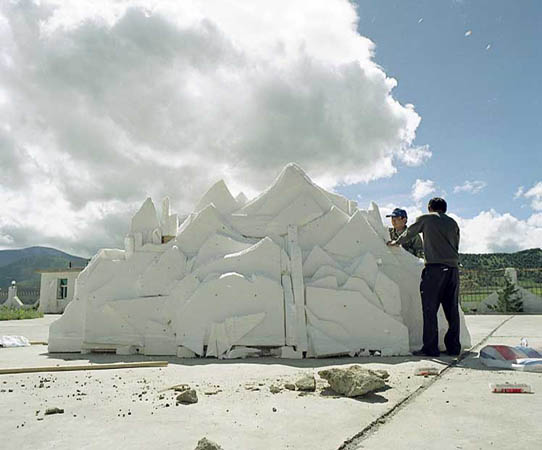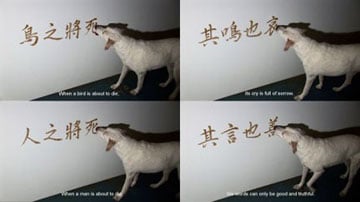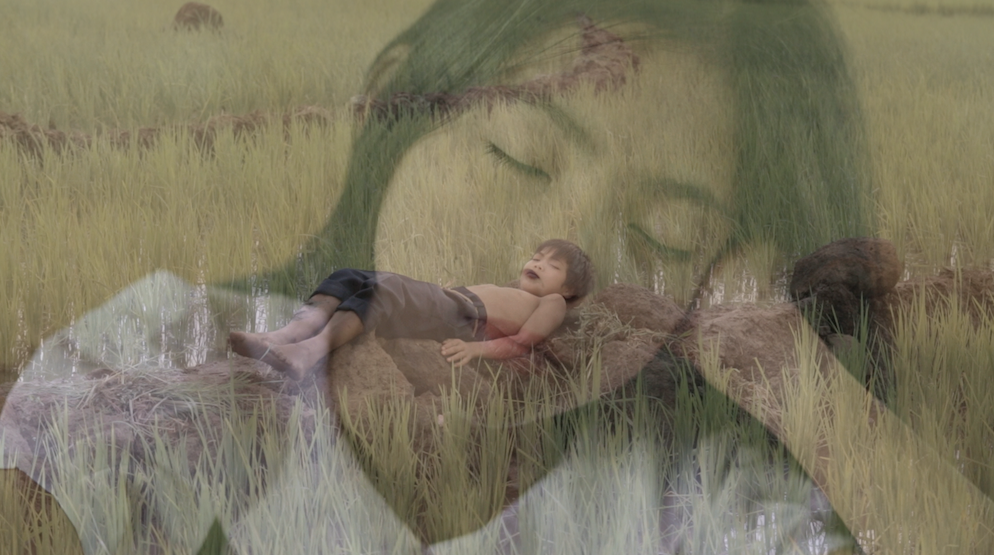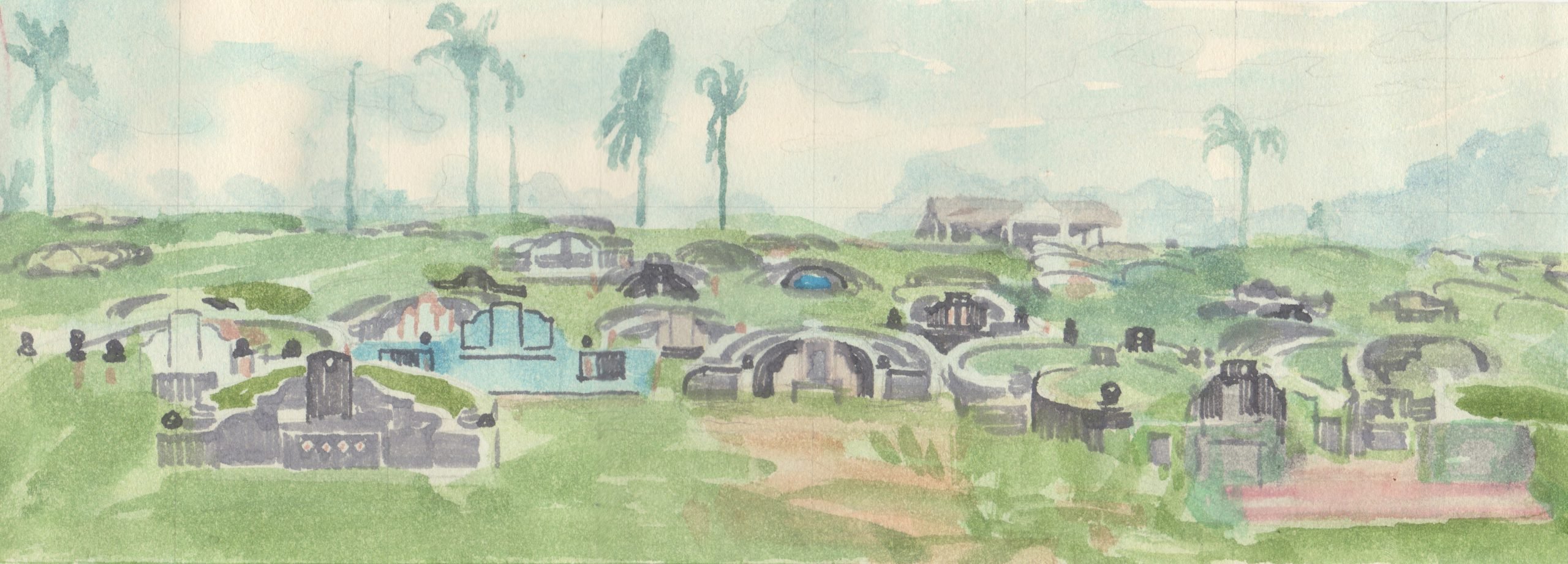
© » KADIST
Park Chan-Kyong
Park Chan-Kyong’s otherworldly film Belated Bosal primarily follows two women as they navigate their way up a spectral mountain and through what appears to be a history museum or nuclear disaster bunker. They converge to jointly perform a funeral rite in a shipping container, which a group of artisans temporarily convert into a makeshift Buddhist temple, replete with traditional paintings. Shot in crisp and densely detailed black-and-white negative, each frame is lit by the format’s spooky incandescence: shadows are white and the sun is black, as if the world were being viewed through X-ray, infrared camera or a plutonium-sensitive film.

© » KADIST
Park Chan-Kyong
Park Chan-Kyong’s film Citizen’s Forest draws on two works for which the artist has a particular fondness: The Lemures , an incomplete painting by Korean artist Oh Yoon, and Colossal Roots , a poem by Korean poet Kim Soo-Young. The Lemures (1984) is a panoramic sketch depicting a procession of victims from major events in modern Korean history, including the Donghak Peasant Revolution, the Korean War, and the Gwangju Uprising. Colossal Roots (1974) is an intellectual text taking into account the multiple layers of unconditional acceptance of traditions while subverting the Orientalist perspective.

© » KADIST
Leelee Chan
Blindfold Receptor (caterpillar-yellow) by Leelee Chan is inspired by the camouflaging nature of the peppered-moth caterpillar. In 1800s Europe, during the industrial revolution, light-colored moths evolved into a darker color after trees in their habitat darkened by the polluting soot. Today, due to rapid human changes to the environment, caterpillars can adapt even before they metamorphose into moths, mimicking the colour of the branches they inhabit.

© » KADIST
Kent Chan
Heat Waves by Kent Chan examines the contexts, politics, and proliferation of the different aesthetics of heat by drawing from the aesthetics of regions defined by hot and humid climates and associated with histories of coloniality such as ‘the global south’ and the ‘developing world’. The video takes the form of a curated broadcast or music video of historical and contemporary imagery and videos of both found and filmed footage, including media broadcasts; TikToks; DJ sets; an interview with Keanu Reeves; an excerpt of Ho Tzu Nyen’s 4 x 4 – Episodes of Singapore Art (2005); an interview with KADIST Collection artist Julian Abraham Togar; and DJ sets. The barrage of footage weaves together contrasting tropes about the tropics: depicting it as a diseased paradise; naturally abundant, yet economically poor; filled with people who are at once energetic and lazy; with dynamic aesthetics, but lacking order.
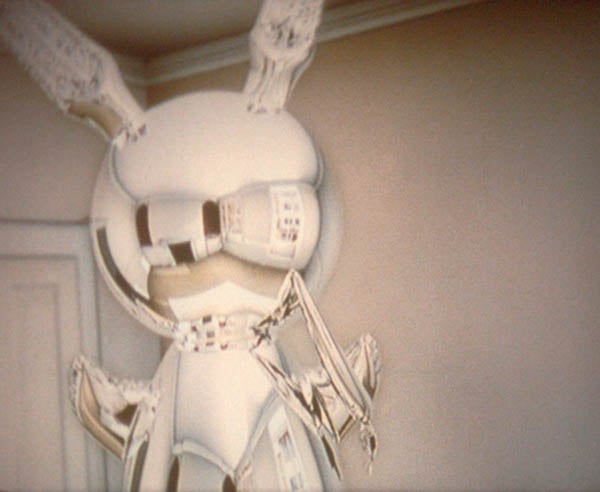
© » KADIST
Mark Leckey
In Made In Heaven , we are face to face with a sculptural apparition, a divine visitation in the artist’s studio. It isn’t just any object, but an iconic sculpture of the end of the 20th century: Jeff Koons’ Bunny. One key question in this work is of course the construction of images, but there is also the question of sculpture, of the passage from two-dimensionality to three-dimensionality.
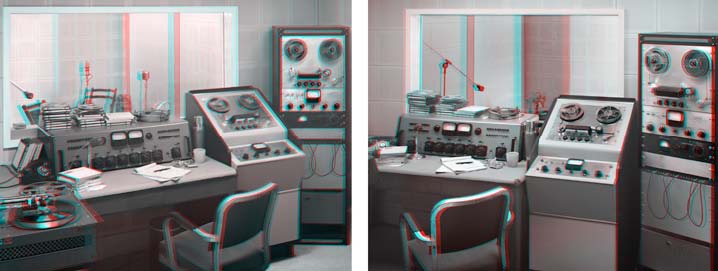
© » KADIST
Mark Soo
The two large-scale stereoscopic photographs in That’s That’s Alright Alright Mama Mama depict a recreation of Elvis Presley’s recording studio in Memphis, Tennessee. This study in doubles is underscored by its title, which repeats and doubles Elvis’s original song title. The images are hung in a specially angled wall and the viewers are provided special 3-D glasses in order to contemplate the image.

© » KADIST
Mark Grotjahn
Drawing & Print (Drawing & Print)
This particular drawing, like many of Grotjahn’s works, presents a decentered single-point perspective. Unlike the traditional vanishing point, the rays here emanate from the surface’s middle and hover around an indefinite and impossible convergence. The resulting fluttering of the image’s sections animates the drawing in relationship to its named subject, the butterfly.

© » KADIST
Mark Bradford
Drawing & Print (Drawing & Print)
This untitled work from 2012 is a print originally made as part of the Wattis Institute for Contemporary Art’s artist limited edition series. It’s contrasting dark and vibrant tones presage his later series of works, exhibited at L. A.’s Hammer Museum as Scorched Earth. These larger works share a map-like quality, looking like aerial views of some scarred urban landscape.

© » KADIST
Baseera Khan
Designed by the artist and fabricated in collaboration with Kashmiri artisans in India, Baseera Khan’s Psychedelic Prayer Rugs combine visual iconography traditional to Islam, such as the crescent moon and lunar calendar, with brightly coloured symbols of personal significance to the artist: a pair of embroidered sneakers, a fragment of an Urdu poem, and the Purple Heart medal. Visually seductive yet charged with political and symbolic associations, the rugs bridge elements of American popular culture with aspects of Islamic worship that may be misunderstood in contemporary secular contexts. Encouraged by Khan to take their shoes off and interact with the rugs, viewers participate in a decolonizing process as they meditate on their poetic allusions or perform the traditional salat, the daily prayers that constitute one of the five pillars of Islam, the others being faith, charity, fasting, and pilgrimage to Mecca.

© » KADIST
Jin Shan
Retired Pillar represents the death and deterioration of legacy of colonial Shanghai. The silicon Corinthian column lays horizontal upon its pedestal, inflating and deflating in the rhythm of difficult breathing, as if exhausted by its lifelong labor. Shan comments on the deterioration of the influence of French colonialism within Shanghai as well as the adoption of Western forms of architectural decoration as symbols of wealth and power.

© » KADIST
Baseera Khan
Designed by the artist and fabricated in collaboration with Kashmiri artisans in India, Baseera Khan’s Psychedelic Prayer Rugs combine visual iconography traditional to Islam, such as the crescent moon and lunar calendar, with brightly coloured symbols of personal significance to the artist: a pair of embroidered sneakers, a fragment of an Urdu poem, and the Purple Heart medal. Visually seductive yet charged with political and symbolic associations, the rugs bridge elements of American popular culture with aspects of Islamic worship that may be poorly understood in contemporary secular contexts. Encouraged by Khan to take their shoes off and interact with the rugs, viewers participate in a decolonizing process as they meditate on their poetic allusions or perform the traditional salat, the daily prayers that constitute one of the five pillars of Islam, the others being faith, charity, fasting, and pilgrimage to Mecca.

© » KADIST
Chen Zhexiang
In the video work Any Resemblance is Coincidental , CHEN Zhexiang mined portraits of real Asian criminals that were abandoned on the Internet. In order to form a database of the portraits, he saved the files under the original names retrieved from the Internet. CHEN used digital facial recognition technology to build a lexicon of the criminals’ facial characteristics in order to analyze them.

© » KADIST
Chen Shaoxiong
After engaging primarily with video and photography for more than a decade, Chen turned to painting to explore the issue of urban change and memories—both personal and collective. This “return to origin” reveals an interesting critical reflection on the interactive relation between outside change and internal reflection, and the possibility for more experimental approaches that revive “traditional media.” Chen’s series Collective Memories depicts some of the most important architectural works and urban sites in modern Chinese society, especially those related to the history of revolutions. Instead of reproducing the images himself, Chen invited the public to participate in their making by using their fingers to paint directly on the paper or canvas.

© » KADIST
Xiaoyun Chen
In the video work Drag, a man in a dark room pulls on the end of a rope. In midst of sounds of heavy breathing, the camera presents alternating scenes of a man and the shadow of a man wearing a long, pointed hat cast against a wall. Insinuating a sinister mood, the man and the shadow struggle to control the scene through alternating tugs and releases of a rope.

© » KADIST
Chen Shaoxiong
After engaging primarily with video and photography for more than a decade, Chen turned to painting to explore the issue of urban change and memories—both personal and collective. This “return to origin” reveals an interesting critical reflection on the interactive relation between outside change and internal reflection, and the possibility for more experimental approaches that revive “traditional media.” For Ink Diary , Chen recorded his daily life and impressions within a rapidly-changing urban setting in ink wash paintings which he then turned into an animated film. The complex result of this simple process is both highly innovative and reflective of modernization.

© » KADIST
Jeamin Cha
In On Guard by Jeamin Cha, a security guard receives safety training, juxtaposed against his patrol of an empty building as he tries to give care instructions for his ailing mother over the phone. The film dismantles the binary oppositions between “caring” and “guarding,” two actions that parallel one another in their emphasis on attentiveness without a logical conclusion. Cha’s exploration of the relationship between these two focuses is channeled through nocturnal urban space, drawing attention to the labor that each requires.

© » KADIST
I-Hsuen Chen
Drawing & Print (Drawing & Print)
Part of the series Still Life Analysis II: The Island , the two photographs The Objects under the Civic Boulevard and A Yellow Blanket on a Wooden Pallet feature household objects of vagrants living beneath the Taipei’s Civic Boulevard expressway. Such objects include trash, unidentified discarded objects, and plants. For the artist, the underside of Civic Boulevard resembles a subtropical island with its artificial stones and potted plants decor.

© » KADIST
Gan Chin Lee
Drawing & Print (Drawing & Print)
In Studies of Chinese New Villages II Gan Chin Lee’s realism appears in the format of a fieldwork notebook; capturing present-day surroundings while unpacking their historical memory. The watercolor images on each note paper document the artist’s visits to various Chinese ‘New Villages’ in Malaysia. The studies, some in color and others in grey-scale, from this series include architectural ruins, portraits of people and animals, and groups of people in protest.

© » KADIST
Gan Chin Lee
Drawing & Print (Drawing & Print)
In Studies of Chinese New Villages II Gan Chin Lee’s realism appears in the format of a fieldwork notebook; capturing present-day surroundings while unpacking their historical memory. The watercolor images on each note paper document the artist’s visits to various Chinese ‘New Villages’ in Malaysia. The studies, some in color and others in grey-scale, from this series include architectural ruins, portraits of people and animals, and groups of people in protest.

© » KADIST
Gan Chin Lee
Drawing & Print (Drawing & Print)
In Studies of Chinese New Villages II Gan Chin Lee’s realism appears in the format of a fieldwork notebook; capturing present-day surroundings while unpacking their historical memory. The watercolor images on each note paper document the artist’s visits to various Chinese ‘New Villages’ in Malaysia. The studies, some in color and others in grey-scale, from this series include architectural ruins, portraits of people and animals, and groups of people in protest.

© » KADIST
Gan Chin Lee
Drawing & Print (Drawing & Print)
In Studies of Chinese New Villages II Gan Chin Lee’s realism appears in the format of a fieldwork notebook; capturing present-day surroundings while unpacking their historical memory. The watercolor images on each note paper document the artist’s visits to various Chinese ‘New Villages’ in Malaysia. The studies, some in color and others in grey-scale, from this series include architectural ruins, portraits of people and animals, and groups of people in protest.

© » KADIST
Phan Thao Nguyên
On September 22, 1940 the French signed an accord, which granted Japanese troops the right to occupy Indochina. The Japanese presence in Indochina lasted until the end of World War II and during the occupation, jute supplies from India were interrupted. Jute was used to make sacks as well as gunpowder, a crucial material for the war industry.

© » KADIST
Yin-Ju Chen
Drawing & Print (Drawing & Print)
This work includes sketches for Extrastellar Evaluations , the project she produced at Kadist. Extrastellar Evaluations introduces Plato’s mythical state of Atlantis as the theoretical birthplace of conceptual art. Well-known and obscure epistemological notions from the annals of cosmology and mysticism guided and informed her research in the Bay Area during the Kadist residency at the beginning of 2016.

© » KADIST
Gan Chin Lee
Drawing & Print (Drawing & Print)
In Studies of Chinese New Villages II Gan Chin Lee’s realism appears in the format of a fieldwork notebook; capturing present-day surroundings while unpacking their historical memory. The watercolor images on each note paper document the artist’s visits to various Chinese ‘New Villages’ in Malaysia. The studies, some in color and others in grey-scale, from this series include architectural ruins, portraits of people and animals, and groups of people in protest.

© » KADIST
Pak Sheung Chuen
Drawing & Print (Drawing & Print)
The series Nightmare Wallpapers represents a shift if Chuen’s practice, allowing the artist to immerse himself in an “artistic pilgrimage of self healing” following the failure of the 2014 Umbrella Movement. These drawings were created during the trial of political activists pursued by the government that the artist would regularly attend. During the tribunal, the artist would let his pen slide freely across his notebook, replicating the automatic drawing techniques of the surrealists.

© » KADIST
Pak Sheung Chuen
Pak created New York Public Library Projects (NYPLP) (2008) during a residency in New York, using public libraries as exhibition spaces and the books they house as raw materials. One of the nine parts of this work is Page 22 (Half Folded Library) , a site-specific installation for which Pak covertly folded dog-ears on page 22 of every second book (a total of approximately 15,500 books) in the 58th Street Branch Library in Manhattan. By claiming it as a “solo exhibition,” Pak intentionally turned a public institution into a private and personal museum where his works are more or less a “permanent collection.” Being open-ended as far as further interpretation (or not) by readers who encounter the folded pages, the project tests the political and social potential of personal gestures in the public realm.

© » KADIST
Jesse Chun
O (for various skies) by Jesse Chun is a two-channel video sculpture that decentralizes American colonial narratives about the moon through “unlanguaging”—a methodology that the artist has conceptualized for unfixing language. The project disrupts bureaucratic documents pertaining to the United States government’s lunar colonization and militarization, such as The Lunex Project of 1958 and Project Horizon of 1959, through methods of visual, semiotic, and sonic (mis)translation and abstraction. Chun redacts the found texts, transforming them into concrete poetry, while interweaving lesser known Korean folklore about the moon, such as the precolonial Korean women’s moon dance ( ganggangsullae ) and shamanistic ritual dance for ushering the departed into another world ( gildakeum ).

© » KADIST
Phan Quang
Phan Quang’s portrait series Re/cover grapples with a lesser-known history in Vietnam. After World War II, many Japanese soldiers who fought in Vietnam stayed in the country. They married Vietnamese women, had children, and lived in the country until Japan recalled them home.

© » KADIST
Xiaoyun Chen
The central point of Vanishing Point is the most direct physiological reaction of the body to the environment. Chen Xiaoyun has added a written narrative and a poetic quality to his works. Image fragments containing different pieces of information are linked together by the text, their interplay producing a synesthesia effect.

© » KADIST
Xiaoyun Chen
The image of rusted nails, nuts and bolts as shrapnel sandwiched between a fried Chicken burger highlights the contrast between decadence and destruction. Chen emphasizes the direct sensational impact of his work to allow his viewer to question the boundary between reality and art. The image of nails as food harks at a visceral relationship with the title, which cries the tone of a manifesto.
Gan Chin Lee
Gan Chin Lee is a Malaysian artist of Chinese descent known across Southeast Asia for his realist paintings that painstakingly register the ethnic and religious complexities of Malaysia...
Xiaoyun Chen
- location: Hangzhou, China
- year born: 1971
- gender: male
- nationality: Chinese
- home town: Hubei Province, China
Yin-Ju Chen
- year born: 2011
- gender: female
- nationality: American & Taiwanese
Jeamin Cha
Jeamin Cha’s questions exist in the gyre between individual and social environment, stepping over conspicuous strands of relation between the two in favor of cultivating characters that dwell in the night, under-noticed or otherwise surplus figures outside of mainstream societal representation...
YOUNG-HAE CHANG HEAVY INDUSTRIES
YOUNG-HAE CHANG HEAVY INDUSTRIES, a partnership between the South Korean artist Young Hae Chang and the American poet Mark Voge, is widely known as a pioneering net art project...
Park Chan-Kyong
Artist and filmmaker Park Chan-kyong was born in Seoul under the reign of Park Chung-hee, whose authoritarian rule transformed South Korea from an impoverished, war-torn country into what the artist describes as a ‘militaristic, repressive, modern state.’ The shadows of Japanese occupation and the Korean War loomed large over the period, driving the call for nationalism and productivity...
Chen Shaoxiong
- location: Beijing
- location: Guangzhou, China
- year born: 1962
- gender: male
- nationality: Chinese
- home town: Shantou, Guangdong Province, China
Pak Sheung Chuen
- location: Hong Kong, China
- year born: 1977
- gender: male
- nationality: Chinese
- home town: Fujian, China
Chen Chieh-Jen
- location: Taipei, Taiwan
- year born: 1960
- gender: male
- nationality: Chinese
- home town: Taoyuan, Taiwan
Mark Grotjahn
- location: Los Angeles, California
- year born: 1968
- gender: male
- nationality: American
- home town: Pasadena, California
Baseera Khan
Designed by the artist and fabricated in collaboration with Kashmiri artisans, Baseera Khan’s Psychedelic Prayer Rugs combine visual iconography traditional to Islam, such as the crescent moon and lunar calendar, with brightly colored symbols of personal significance to the artist: a pair of embroidered sneakers, a fragment of an Urdu poem, and the Purple Heart medal...
Mark Soo
Born in Singapore, raised in Malaysia, and based in Canada, artist and curator Mark Soo’s practice is concept-driven and research-based...
Phan Quang
Visual artist and photographer Phan Quang stages nuanced compositions that illustrate the relationship between global historical events and the personal histories of families and communities in Vietnam...
Cian Dayrit
Cian Dayrit is a Filipino multimedia artist...
Mimian Hsu Chen
Costa Rica-based artist Mimian Hsu works with photography, documents, typography, and objects to construct site-specific installations, performances, and projects that explore intersecting cultural identities...
Leelee Chan
Working in sculpture, Leelee Chan’s visual vocabulary reflects her subjective experience of the extreme urbanization in Hong Kong by proposing a dialogue between concrete materiality, found in heavy industry, and poetics found in ceramics, and its cultural archaeology in millinery Chinese history...
Patty Chang
- location: New York, New York
- year born: 1972
- gender: female
- nationality: American
- home town: San Francisco, California
Kent Chan
As an artist, curator, and filmmaker; Kent Chan’s practice revolves around encounters with art, fiction, and cinema that form a trio of practices porous in form, content, and context...
I-Hsuen Chen
I-Hsuen Chen started focusing on visual arts in the late 2000s after working as a professional opera and choir singer in Taiwan...
Mark Bradford
- location: Los Angeles, California
- year born: 1961
- gender: male
- nationality: American
- home town: Los Angeles, California
Chen Zhexiang
CHEN Zhexiang is a digital media artist and director of animation...
Jin Shan
Jin Shan is an installation artist who uses humor, satire, and play to comment upon social and political power dynamics within contemporary China...
Jesse Chun
Through video, drawing, sculpture, sound, installation, and publications, Jesse Chun’s multidisciplinary practice critically engages with the politics of language...
Mark Leckey
- year born: 1964
- gender: male
- nationality: British
- home town: Birkenhead, United Kingdom
Hung-Chin Peng
There is a palpable urgency in the work of Taiwan-based Peng Hung-Chih, who uses video, sculpture, installation, and painting as means to criticize society...
-
2000-2009
Mark Grotjahn
Drawing & Print
2002(Drawing & Print) This particular drawing, like many of Grotjahn’s works, presents a decentered single-point perspective...
Mark Leckey
2004In Made In Heaven , we are face to face with a sculptural apparition, a divine visitation in the artist’s studio...
Chen Shaoxiong
2006After engaging primarily with video and photography for more than a decade, Chen turned to painting to explore the issue of urban change and memories—both personal and collective...
Xiaoyun Chen
2006The image of rusted nails, nuts and bolts as shrapnel sandwiched between a fried Chicken burger highlights the contrast between decadence and destruction...
Xiaoyun Chen
2006State Terrorism in the ultimate form of Pre-Raphaelite Brotherhood features a portrait of the artist wearing a zipped utilitarian jacket reminiscent of a worker’s uniform, with one arm behind his back as if forced to ingest a bundle of stick—a literal portrayal to the definition of fascism...
Chen Shaoxiong
2007After engaging primarily with video and photography for more than a decade, Chen turned to painting to explore the issue of urban change and memories—both personal and collective...
Pak Sheung Chuen
2008Pak created New York Public Library Projects (NYPLP) (2008) during a residency in New York, using public libraries as exhibition spaces and the books they house as raw materials...
Hung-Chin Peng
2008In Excerpts from the Analects of Confucius , Peng Hung-Chih explores the relationship between Confucianism and religion...
-
2010-2019
YOUNG-HAE CHANG HEAVY INDUSTRIES
2010To the syncopations of a jazzy soundtrack, Korean words in white against a black background flashes between an English dialogue in black text against white ground...
Chen Chieh-Jen
2010Empire’s Borders II – Passage and Empire’s Borders II – Workers are from the three-channel film installation Empire’s Borders II – Western Enterprise, Inc...
Chen Chieh-Jen
2010Empire’s Borders II – Passage and Empire’s Borders II – Workers are from the three-channel film installation Empire’s Borders II – Western Enterprise, Inc...
Yin-Ju Chen
Drawing & Print
2011(Drawing & Print) This work includes sketches for Extrastellar Evaluations , the project she produced at Kadist...
Mark Bradford
Drawing & Print
2012(Drawing & Print) This untitled work from 2012 is a print originally made as part of the Wattis Institute for Contemporary Art’s artist limited edition series...
Xiaoyun Chen
2012The lengthy titles in Chen Xiaoyun’s work often appear as colophons to his photographs that invite the viewer to a process of self realization through contemplating the distance between word and image...
Phan Thao Nguyên
2013On September 22, 1940 the French signed an accord, which granted Japanese troops the right to occupy Indochina...
Phan Quang
2013Phan Quang’s portrait series Re/cover grapples with a lesser-known history in Vietnam...
Jeamin Cha
2013Fog and Smoke is the first video Jeamin Cha made after returning to Seoul from London where she studied and started as an investigation into the meaning of “otherness” in documentary filmmaking...
YOUNG-HAE CHANG HEAVY INDUSTRIES
2013Pacific Limn weaves together three narratives that comment on hyper-capitalism pan-Pacific cities that San Francisco exemplifies...
Xiaoyun Chen
2014The central point of Vanishing Point is the most direct physiological reaction of the body to the environment...
Mimian Hsu Chen
2014In Hsu’s work, Colonia China (2014), the artist documents a Chinese cemetery of Costa Rica’s Limón Province, along the country’s Caribbean coast...
Park Chan-Kyong
2016Park Chan-Kyong’s film Citizen’s Forest draws on two works for which the artist has a particular fondness: The Lemures , an incomplete painting by Korean artist Oh Yoon, and Colossal Roots , a poem by Korean poet Kim Soo-Young...
I-Hsuen Chen
Drawing & Print
2016(Drawing & Print) Part of the series Still Life Analysis II: The Island , the two photographs The Objects under the Civic Boulevard and A Yellow Blanket on a Wooden Pallet feature household objects of vagrants living beneath the Taipei’s Civic Boulevard expressway...
Yin-Ju Chen
2016Through a semi-fictional approach, Extrastellar Evaluations envisions a version of history in which alien inhabitants, the Lemurians, lived among humans under the guise of various renowned conceptual and minimal artists in the 1960s (Carl Andre, Mel Bochner, and James Turrell to name a few)...
Baseera Khan
2017Designed by the artist and fabricated in collaboration with Kashmiri artisans in India, Baseera Khan’s Psychedelic Prayer Rugs combine visual iconography traditional to Islam, such as the crescent moon and lunar calendar, with brightly coloured symbols of personal significance to the artist: a pair of embroidered sneakers, a fragment of an Urdu poem, and the Purple Heart medal...
Baseera Khan
2017Designed by the artist and fabricated in collaboration with Kashmiri artisans in India, Baseera Khan’s Psychedelic Prayer Rugs combine visual iconography traditional to Islam, such as the crescent moon and lunar calendar, with brightly coloured symbols of personal significance to the artist: a pair of embroidered sneakers, a fragment of an Urdu poem, and the Purple Heart medal...
Pak Sheung Chuen
Drawing & Print
2017(Drawing & Print) The series Nightmare Wallpapers represents a shift if Chuen’s practice, allowing the artist to immerse himself in an “artistic pilgrimage of self healing” following the failure of the 2014 Umbrella Movement...
Jeamin Cha
2018In On Guard by Jeamin Cha, a security guard receives safety training, juxtaposed against his patrol of an empty building as he tries to give care instructions for his ailing mother over the phone...
Cian Dayrit
2018Yuta Nagi Panaad (Promised Land) by Cian Dayrit addresses the impacts of the globalized economy and its powerful ideology on the spaces of everyday life...
Jeamin Cha
2018Almost One by Jeamin Cha dives into an uncomfortable meditation on the relationship between socialization, performativity, truth, and childhood, filtered through the optics of a children’s acting class in South Korea...
Yin-Ju Chen
2018Extrastellar Evaluations is a multimedia installation produced during Yin-Ju Chen’s residency at Kadist San Francisco in the spring of 2016...
Park Chan-Kyong
2019Park Chan-Kyong’s otherworldly film Belated Bosal primarily follows two women as they navigate their way up a spectral mountain and through what appears to be a history museum or nuclear disaster bunker...
Leelee Chan
2019Blindfold Receptor (caterpillar-yellow) by Leelee Chan is inspired by the camouflaging nature of the peppered-moth caterpillar...
Gan Chin Lee
Drawing & Print
2019(Drawing & Print) In Studies of Chinese New Villages II Gan Chin Lee’s realism appears in the format of a fieldwork notebook; capturing present-day surroundings while unpacking their historical memory...
Gan Chin Lee
Drawing & Print
2019(Drawing & Print) In Studies of Chinese New Villages II Gan Chin Lee’s realism appears in the format of a fieldwork notebook; capturing present-day surroundings while unpacking their historical memory...
Gan Chin Lee
Drawing & Print
2019(Drawing & Print) In Studies of Chinese New Villages II Gan Chin Lee’s realism appears in the format of a fieldwork notebook; capturing present-day surroundings while unpacking their historical memory...
Gan Chin Lee
Drawing & Print
2019(Drawing & Print) In Studies of Chinese New Villages II Gan Chin Lee’s realism appears in the format of a fieldwork notebook; capturing present-day surroundings while unpacking their historical memory...
Gan Chin Lee
Drawing & Print
2019(Drawing & Print) In Studies of Chinese New Villages II Gan Chin Lee’s realism appears in the format of a fieldwork notebook; capturing present-day surroundings while unpacking their historical memory...
Gan Chin Lee
Drawing & Print
2019(Drawing & Print) In Studies of Chinese New Villages II Gan Chin Lee’s realism appears in the format of a fieldwork notebook; capturing present-day surroundings while unpacking their historical memory...
Gan Chin Lee
Drawing & Print
2019(Drawing & Print) In Studies of Chinese New Villages II Gan Chin Lee’s realism appears in the format of a fieldwork notebook; capturing present-day surroundings while unpacking their historical memory...
Gan Chin Lee
Drawing & Print
2019(Drawing & Print) In Studies of Chinese New Villages II Gan Chin Lee’s realism appears in the format of a fieldwork notebook; capturing present-day surroundings while unpacking their historical memory...
Gan Chin Lee
Drawing & Print
2019(Drawing & Print) In Studies of Chinese New Villages II Gan Chin Lee’s realism appears in the format of a fieldwork notebook; capturing present-day surroundings while unpacking their historical memory...
Gan Chin Lee
Drawing & Print
2019(Drawing & Print) In Studies of Chinese New Villages II Gan Chin Lee’s realism appears in the format of a fieldwork notebook; capturing present-day surroundings while unpacking their historical memory...
Gan Chin Lee
Drawing & Print
2019(Drawing & Print) In Studies of Chinese New Villages II Gan Chin Lee’s realism appears in the format of a fieldwork notebook; capturing present-day surroundings while unpacking their historical memory...
-
2020-2029
YOUNG-HAE CHANG HEAVY INDUSTRIES
2020The absurd condition of human survival under environmental degradation and geonational balkanization is taken as a starting point for WA’AD by YOUNG-HAE CHANG HEAVY INDUSTRIES...
Jeamin Cha
2020Jeamin Cha’s essay-film Ellie’s Eye is an extensive examination of the human mind and the effects of new technology, such as chatbots and virtual avatar therapists on the mental health industry...
Kent Chan
2021Heat Waves by Kent Chan examines the contexts, politics, and proliferation of the different aesthetics of heat by drawing from the aesthetics of regions defined by hot and humid climates and associated with histories of coloniality such as ‘the global south’ and the ‘developing world’...
Chen Zhexiang
2021In the video work Any Resemblance is Coincidental , CHEN Zhexiang mined portraits of real Asian criminals that were abandoned on the Internet...
Jesse Chun
2021O (for various skies) by Jesse Chun is a two-channel video sculpture that decentralizes American colonial narratives about the moon through “unlanguaging”—a methodology that the artist has conceptualized for unfixing language...








